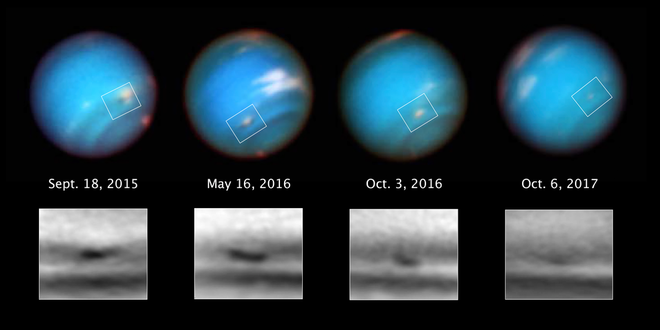
This series of Hubble Space Telescope images taken over 2 years tracks the demise of a giant dark vortex on the planet Neptune. The oval-shaped spot has shrunk from 3,100 miles across its long axis to 2,300 miles across, over the Hubble observation period. Credits: NASA, ESA, and M.H. Wong and A.I. Hsu (UC Berkeley)
Los Angeles
NASA Hubble Space Telescope has captured Neptune's mysterious dark storm that probably smells like rotten eggs, and is shrinking out of existence.
Immense dark storms on Neptune were first discovered in the late 1980s by NASA's Voyager 2 spacecraft, according to the Hubble team.
Hubble found two dark storms that appeared in the mid-1990s and then vanished. This latest storm was first seen in 2015, but is now shrinking.
Like Jupiter's Great Red Spot (GRS), the storm swirls in an anti-cyclonic direction and is dredging up material from deep inside the ice giant planet's atmosphere.
The elusive feature gives astronomers a unique opportunity to study Neptune's deep winds, which can't be directly measured.
The dark spot material may be hydrogen sulphide, with the pungent smell of rotten eggs.
"The particles themselves are still highly reflective; they are just slightly darker than the particles in the surrounding atmosphere," said Joshua Tollefson from the University of California at Berkeley in the US.
Unlike Jupiter's GRS, which has been visible for at least 200 years, Neptune's dark vortices only last a few years. This is the first one that actually has been photographed as it is dying.
"We have no evidence of how these vortices are formed or how fast they rotate," said Agustin Sanchez-Lavega from the University of the Basque Country in Spain.
"It is most likely that they arise from an instability in the sheared eastward and westward winds," said Sanchez-Lavega.
The dark vortex is behaving differently from what planet-watchers predicted.
"It looks like we're capturing the demise of this dark vortex, and it's different from what well-known studies led us to expect," said Michael H Wong of the University of California at Berkeley.
"Their dynamical simulations said that anticyclones under Neptune's wind shear would probably drift towards the equator. We thought that once the vortex got too close to the equator, it would break up and perhaps create a spectacular outburst of cloud activity," said Wong.
However, the dark spot, which was first seen at mid-southern latitudes, has apparently faded away rather than going out with a bang.
That may be related to the surprising direction of its measured drift: toward the south pole, instead of northward towards the equator, researchers said. PTI



























